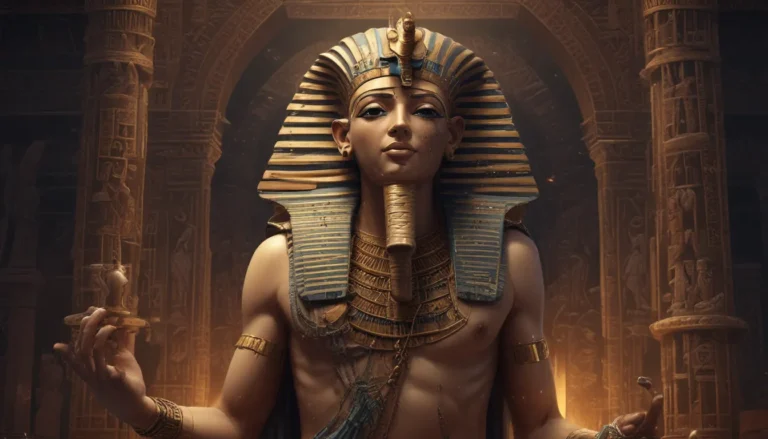The images in our articles may not match the content exactly. They are used to grab your attention, not to show the exact details in the text. The images complement the text but do not replace it.
Manichaeism, a religion shrouded in mystery and intrigue, stands as a testament to the rich tapestry of religious beliefs that have shaped human history. Founded by the prophet Mani in the 3rd century AD, this unique faith offers a glimpse into a world where the eternal struggle between light and darkness defines the cosmic order. As we delve into the depths of Manichaeism, we uncover a trove of fascinating facts that illuminate its origins, beliefs, and cultural impact. Join us on a journey through the enigmatic realm of Manichaeism as we unravel seventeen compelling facts about this ancient religion.
Unveiling the Origins of Manichaeism
Manichaeism traces its roots back to the visionary teachings of the prophet Mani, who emerged in Mesopotamia during the 3rd century AD. With a message that transcended borders, Mani’s doctrine quickly spread across the Roman Empire and beyond, captivating the minds and hearts of diverse followers.
Embracing Dualism: The Core Tenet of Manichaeism
At the heart of Manichaeism lies the profound belief in dualism – the eternal conflict between light and darkness, good and evil. This cosmic struggle permeates every aspect of the religion, shaping its worldview and guiding its followers on the path to spiritual enlightenment.
Navigating the Divine Realms in Manichaeism
In the intricate cosmology of Manichaeism, three distinct realms hold sway: the realm of Light, the realm of Darkness, and the realm of the Living Spirit. These realms symbolize the eternal battle between the forces of good and evil, offering a glimpse into the spiritual hierarchy that governs the universe.
Mani: Prophet and Messenger of Divine Revelations
Mani, revered as both the founder and the final prophet of Manichaeism, claimed to receive divine revelations from a pantheon of religious figures, including Jesus, Buddha, and Zoroaster. His teachings served as a beacon of light amidst the darkness of ignorance and spiritual turmoil.
The Influence of Gnosticism: A Beacon of Hidden Knowledge
Gnosticism, with its emphasis on secret knowledge (gnosis) and the spiritual realm, exerted a profound influence on the development of Manichaeism. The quest for enlightenment and salvation through divine wisdom echoed throughout Mani’s teachings, enriching the spiritual tapestry of the faith.
A Tapestry of Believers: The Spread of Manichaeism
Manichaeism’s allure transcended geographical boundaries, captivating followers across the Roman Empire, Egypt, Persia, and Central Asia. Its popularity soared, rivaling even the dominance of Christianity in certain regions and leaving an indelible mark on the religious landscape.
Delving into Sacred Texts: The Canon of Manichaeism
Central to the religious practice of Manichaeism were sacred texts such as the “Gospel of Mani,” “The Treasure of Life,” and “The Living Gospel.” These scriptures contained the teachings and parables that illuminated the path to spiritual enlightenment for devout adherents.
Embracing Asceticism: The Path to Purification
Manichaeism extolled the virtues of leading an ascetic life, free from the trappings of material possessions. Devout followers practiced abstinence and celibacy, seeking to purify their souls and attain spiritual liberation from the shackles of earthly desires.
The Ritual Tapestry of Manichaeism: A Journey of Devotion
Ritual practices in Manichaeism encompassed a spectrum of spiritual disciplines, from prayer and fasting to communal meals that fostered unity among believers. Through these rituals, followers sought to forge a deeper connection with the divine and nurture their spiritual growth.
The Celestial Dance: Manichaean Dualistic Cosmology
Within the intricate cosmology of Manichaeism, celestial beings such as the First Man and the Primal Light played pivotal roles in the creation and sustenance of the universe. This elaborate framework offered insights into the complex tapestry of existence and the eternal struggle between light and darkness.
The Thorny Path of Opposition: Challenges from Orthodox Religions
Throughout its history, Manichaeism faced vehement opposition from established religions like Christianity and Zoroastrianism. Perceived as a threat to their doctrines, Manichaeism weathered storms of persecution and suppression as it sought to establish its place in the religious landscape.
The Ebbing Tide: The Decline of Manichaeism
By the 5th century AD, the tide began to turn against Manichaeism, as persecution and competition from rival faiths led to its decline in popularity. Despite waning as an organized religion, its legacy endured, influencing subsequent religious and philosophical movements.
Illuminating the Divine Dichotomy: Light and Dark in Manichaeism
Central to Manichaeism’s teachings is the eternal struggle between divine light and dark matter. Light embodies purity and spiritual enlightenment, while dark matter symbolizes ignorance and moral corruption, offering adherents a dualistic lens through which to view the world.
Transcending the Material Realm: The Rejection of Worldly Attachments
Manichaeism contends that the material world is inherently flawed and ensnared in evil. Salvation, therefore, hinges on transcending earthly realms and reconnecting with the divine light that resides within each individual, illuminating the path to spiritual liberation.
The Divine Pantheon: Beings of Light and Darkness
Within the pantheon of Manichaeism, a host of divine beings embody various aspects of the cosmic struggle between light and darkness. These celestial entities play pivotal roles in the intricate tapestry of Manichaean cosmology, offering insights into the complexities of the divine order.
Unveiling the Divine Spark: The Quest for Liberation
Central to Manichaeism is the belief that every individual harbors a divine spark of light within, yearning to be liberated from the confines of the physical body. Through spiritual practices and the pursuit of knowledge, followers seek to awaken this inner light and transcend mortal limitations.
The Enduring Legacy of Manichaeism: A Beacon of Influence
Although Manichaeism waned as an organized religion, its legacy endures in the annals of religious and philosophical history. Elements of its teachings found resonance in subsequent traditions like Gnosticism and the Cathars of medieval Europe, offering a lasting testament to the enduring impact of this enigmatic faith.
In Conclusion: Unveiling the Mysteries of Manichaeism
Manichaeism stands as a testament to the rich tapestry of human belief and the eternal quest for spiritual enlightenment. Rooted in dualism, asceticism, and the teachings of the prophet Mani, this ancient religion captivated followers across diverse cultures before gradually fading into obscurity. Despite its decline, the legacy of Manichaeism continues to resonate in the realms of religious and philosophical thought, inviting us to ponder the eternal struggle between light and darkness.
FAQs: Navigating the Enigmatic World of Manichaeism
Q: What is Manichaeism?
A: Manichaeism is a religious movement founded in the 3rd century CE by the prophet Mani, blending elements of Zoroastrianism, Christianity, and Gnosticism to offer a dualistic worldview.
Q: Where did Manichaeism originate?
A: Manichaeism originated in the Persian Empire, spreading to regions like Iran, Iraq, Central Asia, and the Roman Empire.
Q: What are the core beliefs of Manichaeism?
A: Central to Manichaeism is the belief in the eternal struggle between light and darkness, salvation through knowledge, and the purification of the soul from material attachments.
Q: How did Manichaeism influence other religions?
A: Manichaeism’s dualistic cosmology and emphasis on spiritual enlightenment influenced various traditions like Christianity, Islam, and Buddhism, leaving a lasting imprint on their development.
Q: Is Manichaeism still practiced today?
A: While organized communities of Manichaeans have waned, the legacy of Manichaeism lives on through scholarly inquiry and the enduring impact it has had on subsequent religious and philosophical movements.
Delving Deeper: Our Commitment to Quality Content
Every fact and insight shared on our site is a product of real user contributions, reflecting a rich tapestry of knowledge and diverse perspectives. Our dedicated team of editors ensures the accuracy and reliability of each submission, upholding the highest standards of authenticity and engagement in every piece of content we offer. Trust in our commitment to delivering trustworthy and compelling information as you uncover the mysteries and complexities of Manichaeism and beyond.






